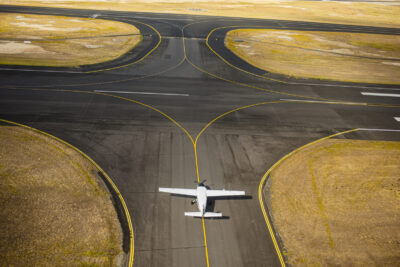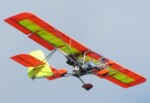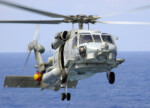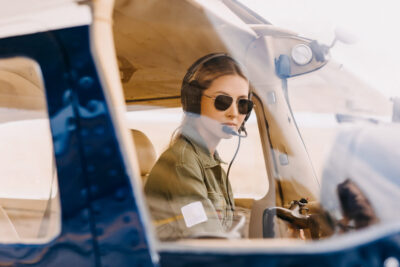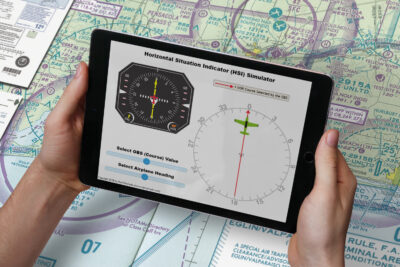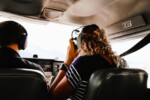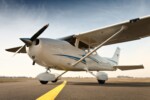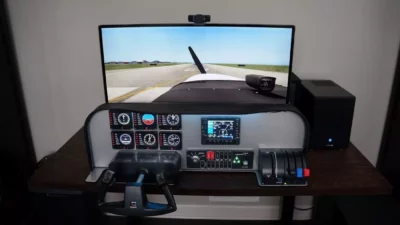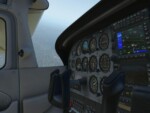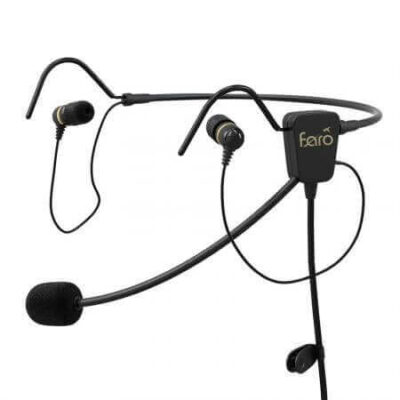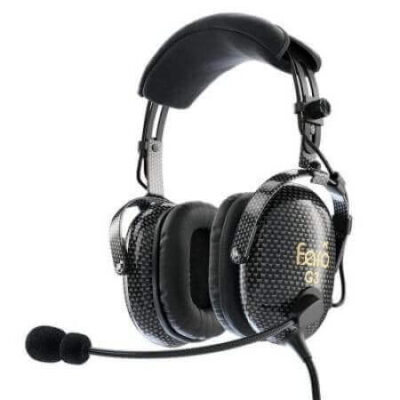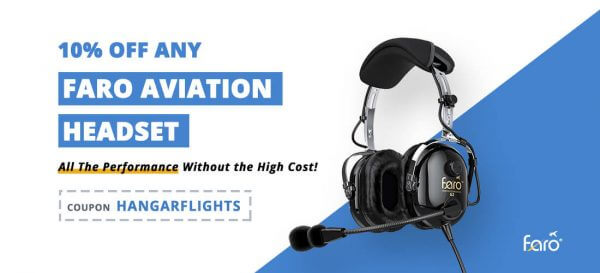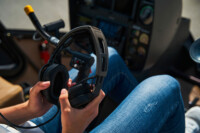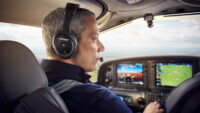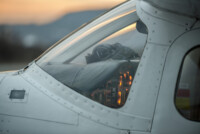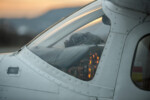The Best Aviation Headsets for Pilots in 2024
6 July 2021 | Updated on February 05, 2024
An aviation headset is one of the most important accessories and tools a pilot has in his cockpit. Hundreds of different headset models and brands are on the market today, but which one should you get? How much should you spend? And what about ANR vs. PNR aviation headsets?
Finding the right aviation headset for you can be confusing, especially given the many different brands out there, promoting their newest models with all the usual bells and whistles. Let us help you make a well-thought-out decision with this definitive guide on how to choose the best aviation headset in 2024!
We will start this guide with a list of some of the best aviation headsets you can buy today. In different sections, we will cover the different budgets for aviation headsets: under $200, under $500, over $500 and lastly the more expensive ones over $1000.
If you want to learn more about aviation headsets, we’ve included a full buying guide at the bottom of this article.
The Best Aviation Headsets Under $200
You can find some great entry-level aviation headsets for $200 or less. These headsets work great for the occasional flyer, student pilots looking to save some money, or as an additional headset for your passengers.
1. Faro G2 PNR
$170.99 $189.99
The Faro G2 PNR is an excellent choice for both student pilots and those looking to save a buck. This headset is a personal favorite and its reliable features make it a worthwhile investment. Offering a great value for money, the G2 PNR remains Faro Aviation’s most budget-friendly option.
Despite being the most affordable model in the Faro lineup, the G2 PNR doesn’t skimp on the features. It boasts a passive noise reduction of up to 26dB, quieter than most other headsets in its class. Its generous cushioning ensures a comfortable experience during long flights, lending a light feel to the headset. The G2 also scores high on aesthetics, available in various colors. It’s equipped with dual volume controls and an MP3/iPhone input, making it an all-round solid starter headset for pilots or their passengers.
The pros of the Faro G2 PNR include its cost-effectiveness and free shipping within the continental US. It’s a headset made by pilots for pilots, which means it understands what you need. The built-in MP3 audio input feature adds to its convenience. On the flip side, its cons include a lack of Active Noise Reduction (ANR), meaning it’s not the quietest out there. The microphone’s sensitivity could also be improved. All things considered, the Faro G2 PNR offers a solid bang for your buck.
2. Rugged Air RA200
$93.99 $105.00
The Rugged Air RA200 aviation headset stands out as one of the most budget-friendly options available for pilots. Its affordability makes it a hit among student pilots and a go-to choice for passenger headsets. Despite its low price tag, the RA200 offers clear sound quality and an auxiliary audio input for MP3. It also features respectable noise cancellation capabilities and is impressively lightweight at only 13.4 oz.
Reviewers online, especially on Amazon, have made this headset an online favorite, earning an impressive 4.6 out of 5-star rating from over 2000 Amazon reviews. The RA200 comes with several beneficial features including a ballistic-nylon bag, flexible mic boom, volume control, and exceptional build quality. The microphone’s sound quality is superb, contributing to the headset’s popularity. However, it’s worth noting that some users have reported discomfort during longer flights due to its tight fit. The microphone may also be overly sensitive for some, and the headset can be a bit bulky. Nevertheless, its benefits far outweigh its drawbacks, making the Rugged Air RA200 an excellent option for pilots seeking quality without breaking the bank.
3. Kore Aviation KA-1
$199.95 $249.99
The Kore Aviation KA-1, much like the ASA HS-1, is an excellent entry-level aviation headset. However, with a slightly higher price tag, between $40 to $50 more, it offers extra features including an MP3 audio input and a carrying case.
Built with great precision, this headset boasts dual volume controls and a flexible mic boom, ensuring clear communication and adaptability. Its noise reduction capacity is excellent, promising uninterrupted communication even in noisy environments. A unique addition is the aux audio input which allows you to connect your smartphone, making this headset not just for pilots but passengers, instructors, and students too. The sound quality it offers is fantastic. Yet, it’s the price that really sets it apart – it’s very affordable. It even comes with a handy carry case. However, be prepared for the gel ear seals to potentially become a little hot during summer (you can purchase washable cloth ear covers separately).
The Best Aviation Headsets Under $500
When you have a little more to spend, we highly recommend upping your budget to $500 or slightly below. This will give you plenty of options with high-quality headsets full of helpful features!
1. David Clark H10-13.4
$379.00
David Clark, a staple in aviation headsets, has earned its stripes with years of service and worldwide use. Their renowned model, the H10-13.4, can be seen in every type of aircraft, across all corners of the globe. As reliable as the sun’s rise, this trusted companion is a common sight among aviators, their DC H10-13.4 headsets a testament to the brand’s robustness.
Despite its marginally higher price tag, the H10-13.4’s comfort and durability make it worth every penny. The ultra-plush, dual foam head pad ensures ease of wear, even on extended flights. While it may lack dual volume controls or an auxiliary audio input, the headset is upheld by David Clark’s renowned quality and service. Opting for the H10-13.4 means investing in many years of dependable use.
As for the pros, it’s a product from a well-established brand, known for great build quality. It comes with an excellent microphone and a volume control knob, offering overall comfort. On the flip side, it does lack an audio input and active noise reduction (ANR), though its noise compression is decent.
2. Faro G2 ANR
$350.99 $389.99
Our next recommended aviation headset is the Faro G2 ANR. It’s an active noise reduction (ANR) variant of the previously mentioned Faro G2 PNR. For an additional $200, this headset provides an impressive noise reduction up to 52dB, ensuring the quietest cockpit environment and offering ultimate comfort. If your budget doesn’t stretch to $500 or above for an ANR headset, the G2 ANR is undoubtedly a top value choice.
We’ve used this headset in our own private pilot license (PPL) flight training, stepping up from the less expensive ASA model. The difference in comfort and noise reduction is instantly apparent when you switch to this remarkable headset. Notable features include MP3 audio input, comfortable leather ear cushions, and free shipping in the Continental US. It’s also worth mentioning that this headset is crafted by pilots, bringing practical understanding to its design. However, it has a couple of drawbacks: the microphone could be more sensitive, and the noise reduction significantly drops when the batteries deplete. Despite these minor cons, the Faro G2 ANR delivers excellent overall value for its price.
We wrote an in-depth review about the Faro G2 ANR aviation headset, check it out here.
3. Faro AIR
$350.99 $389.99
Pilots often endure the burden of heavy headsets for prolonged periods. But the Faro Air is set to flip the script. Weighing in at a mere 28 grams, it earns the distinction of being the lightest and the sole in-ear option on our list. It offers impressive noise reduction capabilities, up to 50dB, rivaling most ANR headsets. This makes it an excellent choice for those on the hunt for a high-performing ANR headset that doesn’t break the bank.
The Faro Air’s compact design and feather-like weight make storage a breeze, effortlessly fitting in your flight bag. Boasting remarkable value, this headset has been crafted by pilots for pilots, and it comes with free shipping in the Continental US. Users will also appreciate the MP3 audio input and comfort it provides, not to mention the end of headset-induced bad hair days! It’s ultra-lightweight at 28g and comes with additional earplugs in various sizes for a customized fit. On the downside, there’s a bit of a learning curve to it, and it might take a few tries to put on correctly. The microphone might not always stay in place, and the fit might not suit everyone’s head shape, so it’s recommended to try it out first.
We wrote an in-depth review about the Faro Air in-ear aviation headset, check it out here.
The Best Aviation Headsets Over $500
Features such as Active Noise Reduction and Bluetooth often require a slightly higher budget. Below are some great options you can find for $500 and up.
1. Lightspeed Sierra ANR
$699.00
Looking for a good ANR headset that won’t break the bank? Consider the Lightspeed Sierra. This active noise reduction (ANR) headset from Lightspeed Aviation is a hit with pilots, students, and passengers alike. It’s a solid choice if you’re careful with your cash but still want high-quality gear.
The Sierra boasts top-tier features like superb noise cancellation and full Bluetooth integration. It’s also compatible with FlightLink, Lightspeed’s in-cockpit recording app. For anyone entering the world of ANR headsets, the Lightspeed Sierra is a perfect starting point.
2. Faro G3 ANR
$620.99 $689.99
The Faro G3 ANR is a featherlight aviation headset, tipping the scales at just 255 grams. It’s the first of its kind to be crafted from Carbon Fiber, making it nearly two times lighter than your typical on-ear models.
This headset isn’t just light, it’s packed with features every pilot wants. It’s priced reasonably and boasts excellent active noise reduction. With Bluetooth, MP3 audio input, and ultra-comfy ear cushions, the G3 offers unbeatable comfort and convenience. Plus, it comes complete with a handy headset bag and audio cable.
3. David Clark DC Pro-X2
$879.85 $895.00
David Clark has made a big splash with their latest model, the Pro-X2. Building upon the success of their previous top-selling models, this headset introduces first-rate Hybrid electronic noise cancellation paired with Bluetooth wireless technology. Remarkably, it’s all housed in a durable and lightweight magnesium alloy frame.
The DC Pro-X2 shines in the weight department, too. At a mere 215g, it’s the lightest over-ear headset in our lineup. It’s not just lightweight but also compact and foldable, making it a cinch to store in the included David Clark soft-sided headset bag. This easy portability is a real bonus for pilots on the go.
4. Lightspeed Zulu 3
$899.00
Lightspeed's Zulu 3 is their top-of-the-line aviation headset. The new model brings you contoured earseals for less pressure on your ears. You’ll also find sturdier, more flexible cables that can take a beating. What’s more, it features the tried-and-true Active Noise Reduction (ANR) tech that other Lightspeed models are known for. The Zulu 3 also includes two smart features: Auto Shutoff and ComPriority. These help extend your battery life and boost your safety in the skies.
Like the Lightspeed Sierra, the Zulu 3 works great with FlightLink. This is Lightspeed’s own recording app for use in the cockpit. So, if you’re after a top-notch aviation headset that delivers comfort, durability, and smart technology, Zulu 3 is worth a look.
We often get asked about the differences between the LightSpeed Zulu 3 and the Bose A20/LightSpeed Sierra, as they are all very popular and great options.
So we have recently written 2 separate guides about the Lightspeed Zulu 3 vs. Bose A20 and the Lightspeed Zulu 3 vs Lightspeed Sierra!
5. Bose A20
$1,207.75
If you have ever used Bose headphones or other audio systems, you know what superior sound quality the company’s speakers can produce. The A20 aviation headset is engineered to be more comfortable and provide more noise reduction than any headset Bose has ever made, while still delivering the clear audio you expect from them.
The A20 is one of the most comfortable headsets, if not the most comfortable one, we have used. The soft leather ear cushions and the comfortable fit of the headband make this headset very comfortable, especially on longer flights.
At this price point, you expect the best. The Bose A20 does a great job delivering just that.
The Bose A20 is available with or without Bluetooth. The non-Bluetooth version is slightly less expensive, but if you’re spending quite a bit of money on a Bose, we highly recommend going in all and getting the Bluetooth version. This way you won’t have to pay the +- $299 for the Bluetooth module when you change your mind later!
Not entirely convinced yet? In another guide, we listed 10 reasons why you should purchase a Bose A20, just like we did!
6. Bose A30
$1,299.00
With its price point of just almost $1,300, the new Bose A30 Bluetooth aviation headset is about the most expensive on this list.
The A30 succeeds the A20 introduced nearly thirteen years ago. It is an entirely new product designed to offer pilots the best in comfort, noise reduction and audio clarity.
Bose engineers designed the A30 as an entirely new platform based in part on input from pilots. The A30’s new features include reduced clamping force for greater wearer comfort, improved clarity and a new digital active noise cancellation system that enables three modes (high, medium and low) of noise cancellation.
Users can connect wirelessly to mobile devices, audio systems and electronic flightbags. Bluetooth audio can be mixed with intercom audio or allow intercom transmissions to temporarily mute Bluetooth.
7. Bose ProFlight Series 2 Aviation Headset
$1,045.00
And finally, there is the Bose Proflight in-ear aviation headset.
The Proflight is the smallest, lightest, most comfortable headset from Bose. Lightweight, in-ear active noise cancellation for long-term comfort over extended flights, with many new features designed specifically for airline and corporate aircraft flight decks.
Bose frequently received the question “Will this headset work in my GA aircraft?” – Bose: “The ProFlight is designed and best suited for quiet to moderate noise levels in flight decks of pressurized turbine-powered aircraft. […] The ProFlight is not recommended for use in single or multi-engine piston aircraft. If you fly that type of plane, the Bose A20 Aviation headset is still your best option.”
Not quite sure whether you should go with the Bose A20 or Bose ProFlight Series 2? Check out our article comparing both Bose aviation headsets in more detail!
Why do You Need an Aviation Headset?
An aviation headset is easily one of the most important purchases you make as a pilot, apart from an aircraft of course. Your headset will be your tool to communicate with others inside and outside of the aircraft. Not only will it help you communicate, it will also play an even bigger role: protecting your hearing.
Some theory to illustrate why this is important:
Our human hearing system is sensitive to sound frequencies between 20 Hz and 20,000 Hz and amplifies the sound between 2,000 and 5,000 Hz, since that’s where our human voice is situated. While sound frequencies are measured in hertz (Hz), the volume or intensity of sound is expressed in decibels (dB). A quiet room is around 40dB and a normal conversation around 50-80dB. Our hearing is sensitive to these so-called sound pressure levels (SPL), but it’s also very vulnerable to sounds with higher intensity, such as a rock concert or, more importantly in our case, airplane engines (120-130dB).
When you are exposed to sounds of 90dB and more, you risk damaging your inner ear, resulting in temporary or worse, permanent hearing loss.
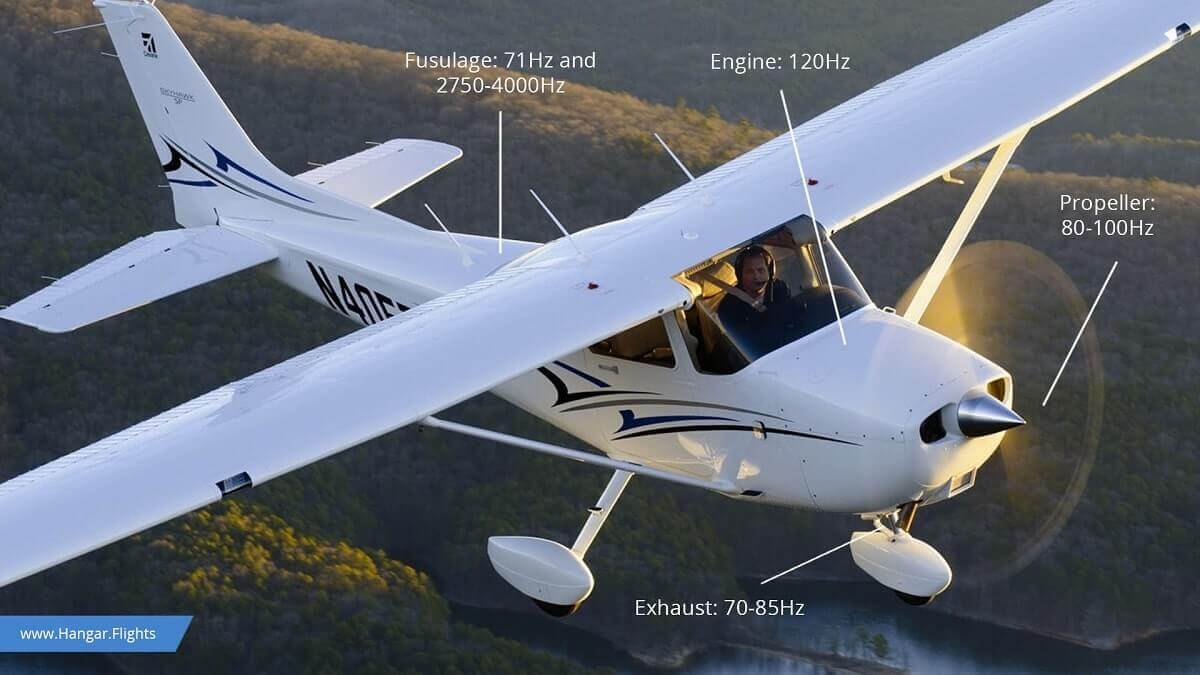

Pilots are exposed to high volumes, and usually in low frequencies, often for long periods at a time. Hearing loss can and, unfortunately, will occur if you’re not protecting your ears properly. The good news is, you can protect them! The key to this is having a quality aviation headset that does a good job handling and reducing these potentially dangerous noises.
Some more interesting reading material about the risk of loud noise and the importance of hearing protections can be found in this FAA safety brochure.
That’s why having a decent aviation headset is crucial, not only for safety when flying, but also to protect your own ears. Since hearing loss is irreversible, prevention is always better than cure. Exactly the reason why we decided to write this comprehensive guide with everything you need to know about purchasing the best aviation headset for your needs.
Types of Aviation Headsets
First of all, it’s important to distinguish a few different types of headsets. The main differences are the noise reduction technology the headset uses and the general look of the headsets.
In-ear vs on-ear
Just like normal headphones people use in their everyday life, aviation headsets come in two main categories. On one hand, you have the on-ear headsets, these are the most commonly used ones. On-ear headsets also offer the biggest choice of brands and models on the market. Well-known examples of on-ear headset brands are David Clark, Bose, Sennheiser and Lightspeed.
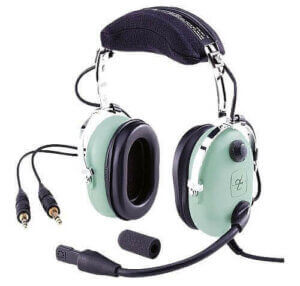

The David Clark H10-13.4 on-ear aviation headset
The second category cover the so-called in-ear aviation headsets. These headsets use little speaker plugs you insert in your ear, just like the headphones of your smartphone. These headsets are a little less common, but offer the great advantage that they are usually more comfortable and weigh a lot less (and don’t cause bad hair days!). However, the way they feel and sit on your head mostly depends on your ears. While on-ear headsets fit almost everyone, in-ear headsets can feel different from person to person. Good examples of in-ear headsets are the Faro AIR and Clarity Aloft headsets (more information about those headsets can be found later in this guide).
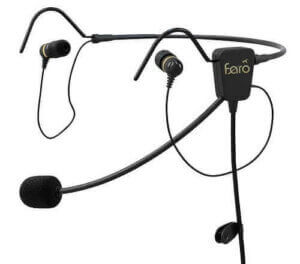

The Faro Air in-ear aviation headset
PNR vs ANR & DNR Aviation Headsets
The second category of headsets is based on their ability to reduce or cancel noise and the noise reduction technology they use. We’ll discuss passive noise reduction (PNR), active noise reduction (ANR) and dynamic noise reduction (DNR) headsets.
Passive noise reduction (PNR)
Passive noise reduction headsets are usually the least expensive ones. They have noise suppressing foam that fills the earcup cavity and passively reduces the noise by sealing off sounds that come from outside the headset. For proper noise reduction, PNR headsets should fit firmly around the side of your head.
PNR headsets can range anywhere from $60 to $600.
Active noise reduction (ANR) and Dynamic noise reduction (DNR)
ANR headsets actively reduce and cancel the noise by using electronics inside the headset to remove or suppress unwanted aircraft noise. These headsets are usually battery-powered and use a filter to separate the wanted signal from the unwanted signals, usually below 300Hz. The separated noise is inverted and mixed with the original signal, which results in the noise and inverted noise-canceling each other. ANR headsets use a little microphone inside the headset to ‘read’ incoming noise and generate the anti-noise signal.
Active noise reduction headsets can usually obtain a noise reduction of 10-20dB, which means at 20dB, the noise is only 1/100th of the original level. Since you don’t want to block wanted signals, like alerts or a sputtering engine, ANR headsets only block frequencies below 300Hz. ANR headsets are in most cases more expensive than their passive noise reduction counterparts.
There is also another kind of active noise canceling headsets, the dynamic noise reduction (DNR) headsets. These are more expensive than ANR headsets, but are lighter and provide an extra level of noise-canceling by using digital electronic techniques to remove noise components from the incoming headphone signal. DNR headsets achieve this by digitizing signals in a series of numerical values, which are then processed to look for repetitive noise signals and remove noise components.
DNR headsets suppress noise by 15-25dB and noise signals of up to 3,500Hz can be detected and canceled. They can range in price from $250 up to $1500.


Want to learn more about PNR, ANR and DNR? Check out our separate article comparing noise reduction technologies!
Microphones of Aviation Headsets
It’s not only important to look at the types of headphones and their ability to cancel incoming noise, we’ll also need to take into account the outgoing sounds from the microphone.
If the microphone of your headset does not have any suppression against noise pick-up, this noise can enter the audio system of the intercom in your airplane, or be transmitted over the radio to other aircraft and ATC, making your calls a lot less clear and understandable. You might have noticed a lot of microphones have a mic muff, or windscreen, to offer some suppression of cabin noise, but by itself, this is not enough to prevent all unwanted noise from entering your mic.
Like the earmuffs, microphones need a quality noise-suppressing foam muff. In addition to this, a ‘jacket’ over the foam will increase its effectiveness. Always make sure to pay attention to the microphone when purchasing a headset.
Most modern aviation headsets have an electret microphone.
Things to Consider When Buying an Aviation Headset
When purchasing a headset, there are a few other things to consider than just the way they reduce noise.
Comfort
Comfort is key when it comes to choosing a new headset. You’ll be wearing these for hours on end, so make sure they fit and feel comfortable before going through the rest of this process! Be mindful of what ear cushions or headband materials are used and check if those factors could contribute significantly towards feeling discomfort after long periods of usage (they might). Some headsets have the bad characteristic of putting increased side pressure on your head after wearing them for a while. Be sure to wear the headset for at least 10 minutes to really feel how they sit.
Some aviation headsets also have replaceable ear seals or padding that can be replaced when worn out.
Bluetooth


The Bose A20 aviation headsets can be purchased with or without Bluetooth capability.
A common option for modern headsets is Bluetooth capability. Lots of devices, like GPS systems and smartphones, can be connected to headphones via Bluetooth, eliminating the need for extra cables in the cockpit. Having Bluetooth functionality on your headset can be a big advantage and a good reason to pay a little extra.
Headsets equipped with Bluetooth functionality are often a little more expensive than the ones without, so if you’re looking for a bargain, finding a cheap non-Bluetooth headset might be the easier option.
However, it’s good to note that aviation headsets that do not include Bluetooth functionality can often be connected to other devices via a standard audio AUX cable, allowing you to still connect your devices to your headset for audio input.
Noise Reduction
We’ve already discussed the different types of noise reduction of headsets. Deciding whether to buy a PNR or ANR headset depends on a few different factors.
First of all, set a budget for yourself and buy accordingly. ANR headsets can cost significantly more than PNR, but if you have the budget for it, ANR would be the best way to go.
Secondly, you’ll need to think about how often you will use your headset. Are you going to use it only a few times a month, or will you be flying with it daily for hours at a time? If you’re going to use your headset daily, you might find ANR headsets a better option since they will significantly reduce the noise you are exposed to, saving your hearing over time.
You should consider the headset an investment in your comfort and health, so it never hurts to spend a little extra on longer-term comfort.
Cable and plugs
Depending on the type of aircraft you’re going to fly, another type of headset plugs are required. Helicopters, for example, use other connectors than fixed-wing GA (general aviation) airplanes, and manufacturer Airbus uses another connector, XLR, which is also used in professional audio recording.
In general, aviation headsets will come in 4 different types of jacks:
- Standard twin/dual plugs: also referred to as GA plugs, these are most common in general aviation aircraft.
- Helicopter/military plug (U174): You may find these in most military aircraft and military/civil helicopters.
- 6-pin LEMO plug: when using an ANR headset that requires batteries to run, this type of plug will supply power to your headset through the aircraft’s battery; it can be found in some privately owned or commercial aircraft.
- Airbus XLR plug: Airbus aircraft are usually equipped with another type of plug, XLR, which is also a popular connection type used in the audio industry.


Always make sure to check which connectors and cables you’ll need and buy the correct one. However, it’s a good idea to buy a headset with the plugs you will use most often as many adapters are available which you can use to convert your plugs to another type for use in different aircraft.
For example, if you’re mostly flying GA aircraft in a flying club, you’d probably be best buying a headset with twin plugs. If after some time, you start flying aircraft with a LEMO-type jack, you can just buy a simple twin plug to LEMO adapter.
Here are a few examples of popular headset adapters:


$49.99
Buy now on Amazon

$32.85
$35.50 

Weight
The weight of your headset can be another factor to take into account. PNR headsets are less expensive, but they are usually also heavier since the earcups contain noise-reducing foam.
However, because ANR headsets need batteries to run, they usually come with an audio module attached to the cable, which again increases the overall weight of the headset assembly. For example, the Faro G2 PNR and ANR versions both have the same weight (20oz, 565g), since the ANR comes with an additional Bluetooth/battery module, while the G2 PNR just uses a heavier ear cup construction.
Again, make sure to wear a few headsets to see which feels the most comfortable. Heavier doesn’t necessarily mean less comfortable.
Price
We’ve already touched on the price point of different headsets and mentioned ANR headsets are more expensive than their PNR counterparts, with DNR headsets even more expensive. As mentioned before, investing in a quality headset is an investment in your comfort and health. You really don’t want to buy a cheap PNR aviation headset to find out that you’re not able to wear it for more than 30 minutes at a time. If you have to buy additional headsets in the near future because you want to upgrade, it may often be cheaper to invest in a quality one from the start.
PNR headsets can range anywhere from $60 to $600. ANR headsets can range anywhere from $300 to $1100.
Just set a budget for yourself and stick to it. If you can afford a more expensive one, it could be the right thing to do. When in doubt, the best advice is still to “buy the most headset you can afford”.
Headset Care and Maintenance Tips
Maintaining your aviation headset is crucial for ensuring its longevity and performance. Here’s a brief overview of essential maintenance tips, with a more detailed guide available in our comprehensive article on headset care.
Cleaning and Inspection:
- Clean regularly: Use a soft cloth for earcups and ear seals. Avoid alcohol-based cleaners to prevent damage.
- Inspect cables: Look for signs of wear or damage and gently straighten out any twists.
Storage:
- Protective case: Always store your headset in a case to shield it from dust and physical damage.
- Avoid extreme temperatures: Don’t leave your headset in very hot or cold environments to protect its materials and components.
Battery Care (for ANR Headsets):
- Check and replace batteries: Ensure optimal performance by regularly replacing the batteries.
- Remove batteries: If not using the headset for an extended period, remove the batteries to prevent leakage.
Professional Repairs:
- For any issues beyond basic maintenance, seek professional repair services to avoid further damage.
For pilots looking to dive deeper into the nuances of aviation headset maintenance, our full article covers everything from detailed cleaning techniques to advanced care strategies, ensuring your headset remains a reliable companion in the skies.
Frequently Asked Questions About Aviation headsets
In the above buying guide, most of your questions should have been answered. But, as you can expect from such an important topic as aviation headsets, many questions may remain unanswered. To help you make a more informed purchase, we’ve compiled a list of the most frequently asked questions about aviation headsets.
What headsets do airline pilots use?
Depending on the specific airline, airline pilots may use their own headset or one offered by the airline. When pilots use their own headset, the headset must meet certain FAA/EASA standards and requirements and have the right adapter for the aircraft. Airbus, for example, uses another adapter (XLR) than Boeing aircraft (twin- plugs or sometimes LEMO).
How long is the cord on an aviation headset?
The cord length varies depending on the specific model of headset, but it’s normally around 50-70 inches (130-175cm). Aviation headsets designed for helicopters usually have a shorter coil cord, to allow for a more flexible cord length.
What brand of headphones do pilots use?
Many different headset brands are used by pilots, but a few major brands are most popular: David Clark, Bose and Lightspeed. While each manufacturer creates quality headsets, the majority of airline flight departments have decided to go with the Bose A20 headset and the Lightspeed Zulu. Of course, many other great options exist.
How long does an aviation headset battery last?
Aviation headset batteries will last between 20 and 45 hours of continuous use, depending on the type of battery and make/model of headset. For example, the Bose A20 can last up to 45 hours and the Faro G2 ANR up to 30 hours on 2 new AA batteries. The exact duration will also depend on the amount of noise reduction required.
What pilot headset should I buy?
Many different brands and models of aviation headsets exist today, and the right one for you will depend on your specific needs, wishes and requirements. In general, you get what you pay for. When in doubt, the best advice is still to buy the most headset you can afford.
How much does an aviation headset cost?
Aviation headsets vary in price depending on the specific model and features, but a quality aviation headset will normally cost between $200-$1000. Quality headsets can last for a decade, so it will be an investment that will pay off.
Why do aviation headsets cost so much?
Aviation headsets are usually more expensive than normal headphones because they require more complicated components and technology, need to withstand more constant use and abuses of the environment, and must be tested and approved to very specific standards.
The price of an aviation headset is also determined by features (Bluetooth vs non-Bluetooth), branding (ASA vs Bose), comfort (leather vs gel ear seals), noise reduction (ANR vs PNR) and overall build quality.
Do airline pilots buy their own headsets?
Depending on the specific airline, airline pilots may use their own headset or one offered by the airline. When pilots use their own headset, the headset must meet certain FAA/EASA standards and requirements and have the right adapter for the aircraft. Airbus, for example, uses another adapter (XLR) than Boeing aircraft (twin- plugs or sometimes LEMO).
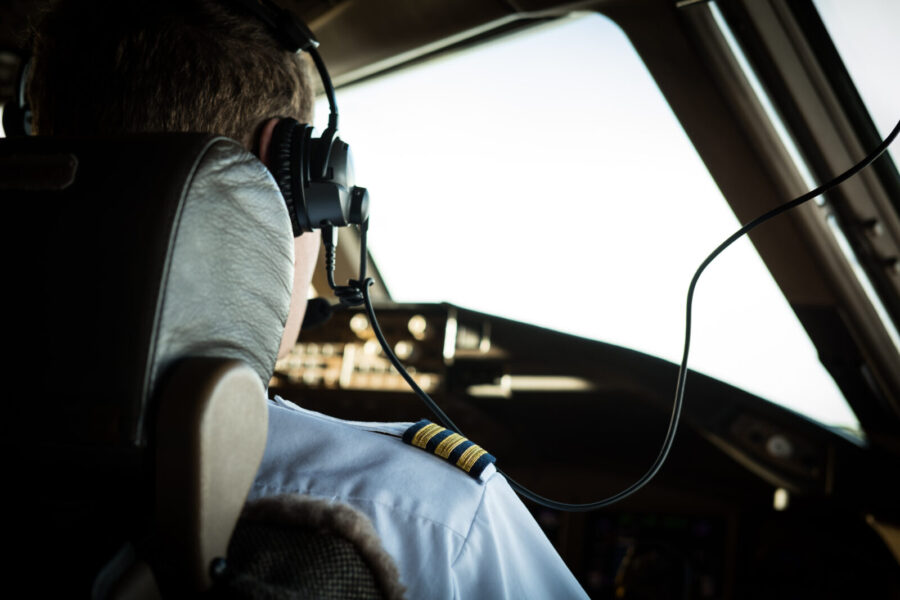

What jacks do aviation headsets use?
Depending on the type of aircraft you’re going to fly, another type of headset plugs is required. Helicopters, for example, use other connectors than fixed-wing GA airplanes, and manufacturer Airbus uses another connector, XLR, which is also used in professional audio recording. Always make sure to check which connectors and cables you’ll need and buy the correct one.
Why do aviation headsets have two plugs?
When aviation headsets have two plugs, one is used for the audio output from the radio (headphones) while the other is the microphone jack. Twin plugs are mostly found in general aviation aircraft, hence why they are also referred to as GA plugs.
Other aviation headsets may also have just a single plug, like XLR, LEMO or U174.
What is a PNR Aviation headset?
PNR stands for passive noise reduction. PNR headsets have noise suppressing foam that fills the earcup cavity and passively reduces the noise by sealing off sounds that come from outside the headset. For proper noise reduction, PNR headsets should fit firmly around the side of your head.
PNR headsets can range anywhere from $60 to $600.
What is an ANR Aviation headset?
ANR stands for active noise reduction. ANR headsets actively reduce and cancel the noise by using electronics inside the headset to remove or suppress unwanted aircraft noise. These headsets are usually battery-powered and use a filter to separate the wanted signal from the unwanted signals, usually below 300Hz.
ANR headsets can range anywhere from $300 to $1100.
Are ANR headsets worth it?
ANR headsets can cost significantly more than PNR, but if you have the budget for it, ANR would be the way to go. Protecting your hearing is crucial in aviation. The best way to do this is by wearing a headset with active noise reduction, since these will significantly reduce the noise you are exposed to.
Do ANR headsets protect hearing?
Not only does an aviation headset help you communicate, it will also play an even bigger role: protecting your hearing. When you are exposed to sounds of 90dB and more, you risk damaging your inner ear, resulting in temporary or worse, permanent hearing loss. Active noise reduction headsets can usually obtain a noise reduction of 10-20dB, which means at 20dB, the noise is only 1/100th of the original level.
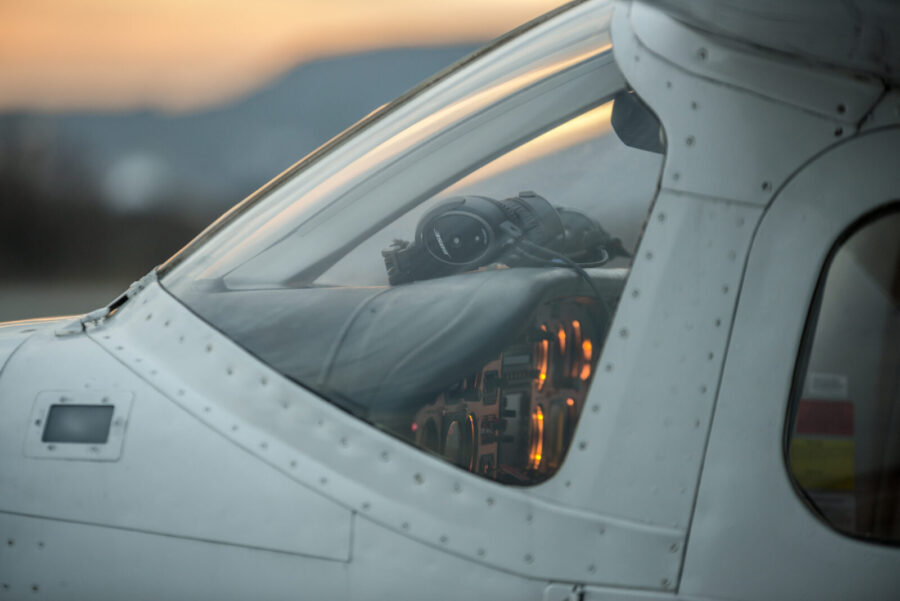

What is the difference between ANR and PNR?
PNR stands for passive noise reduction. Passive headsets use foam or gel to passively reduce any outside noise that enters the earcups, while active noise reduction actively removes unwanted aircraft sound, using a little microphone inside the headset to ‘read’ incoming noise and generate the anti-noise signal.
What is a DNR Aviation headset?
DNR stands for dynamic noise reduction. These are more expensive than ANR headsets, but are lighter and provide an extra level of noise-canceling by using digital electronic techniques to remove noise components from the incoming headphone signal, by digitizing signals in a series of numerical values.
DNR headsets can range in price from $250 up to $1500.
What is a LEMO jack/plug?
A 6-pin LEMO headset plug is used to power ANR aviation headsets through the aircraft’s batteries/electrical system instead of the headset batteries. It can be found in some privately owned or commercial aircraft and eliminates the risk of running out of battery mid-flight.
Why are helicopter headsets different?
A helicopter headset serves the same purpose as any other aviation headset, but it is often wired differently. Helicopter headsets usually come with a coiled cord and a U174 military/helicopter plug. The coiled cable is more flexible, and the cord does not whip about the cockpit or get tangled up, especially given that many helicopters have jacks installed in the cockpit ceiling.
Helicopter pilots also sometimes wear helmets with build-in headphones instead of regular headsets.
Do flight schools provide headsets?
Many flight schools will provide aviation headsets to their students as part of their training program. However, this is not always the case, so it’s important to ask your flight school if headsets are provided and if not, which type you will need for your training.
Often, students who registered for an integrated flight training program will be provided with all the necessary tools and gear, including a flight bag and headset.
Conclusion
In general, you get what you pay for. Quality headsets can last for a decade, so it will be an investment that will pay off. If you’re still not sure which one you should buy, ask a few pilot friends or people at your airfield if you can borrow theirs for a test flight. Always be aware of cheap headsets, they can be attractive but will do a very poor job protecting your ears.
When in doubt, the best advice is still to buy the most headset you can afford.
Our aviation headset recommendations
Don’t forget to gear up with other essential pilot tools like flight bags, watches, and sunglasses to ensure you’re fully equipped for your next adventure above the clouds.
Clear skies and safe flights to all our fellow aviators!
